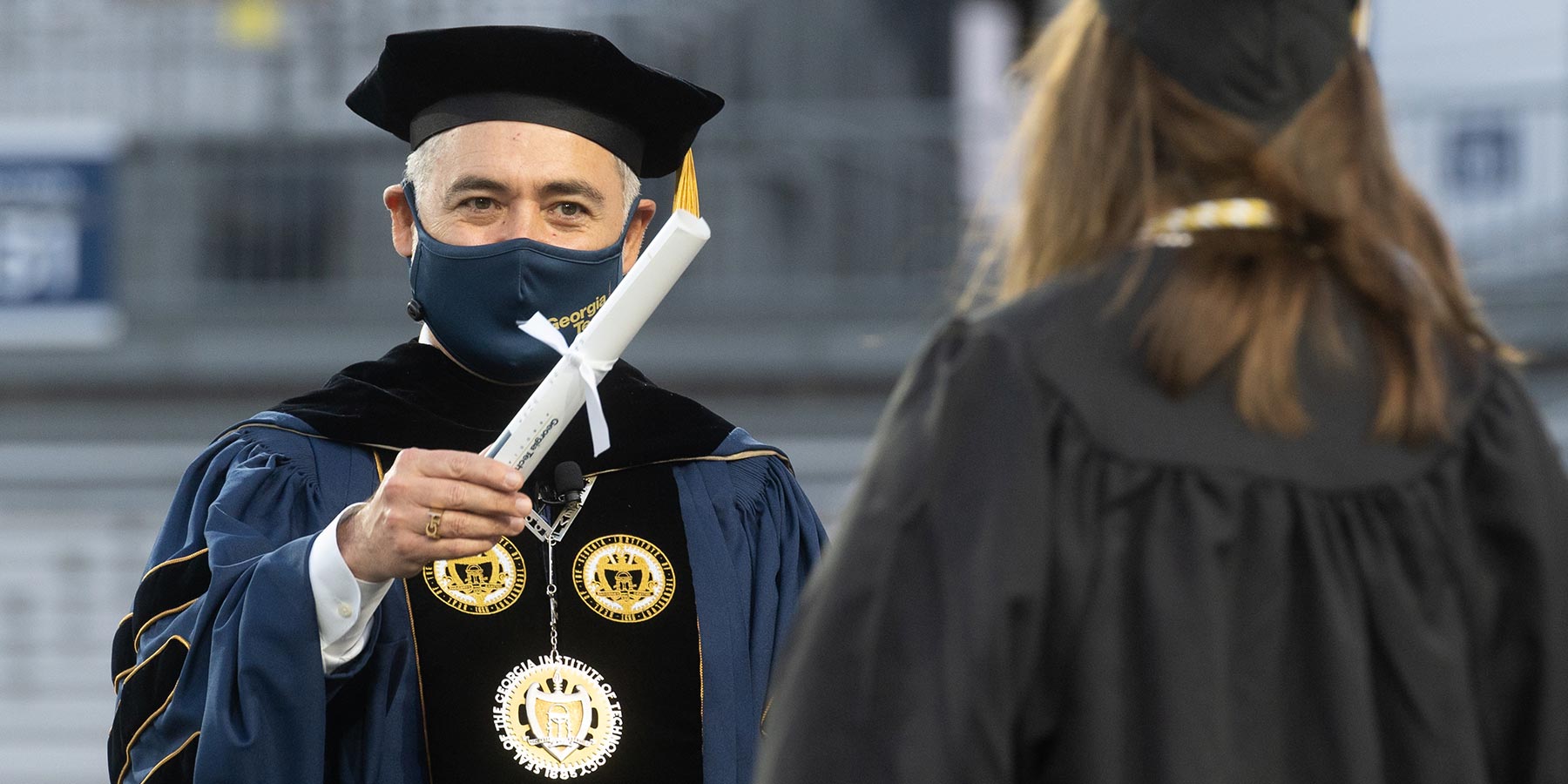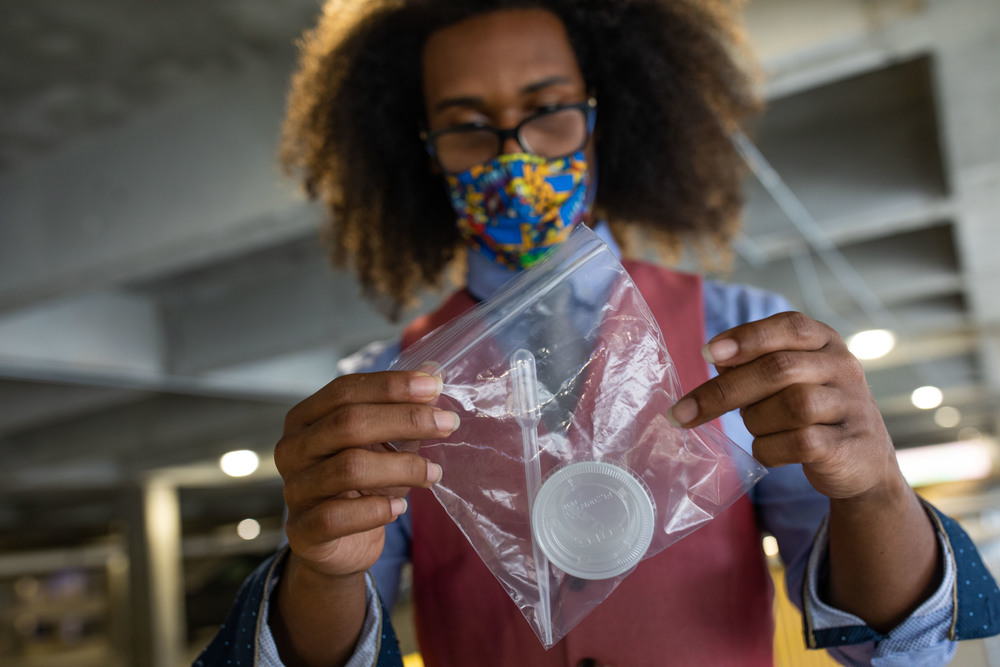
Living Our Mission and Our Values
Dear Georgia Tech Community:
This past year was one of the most remarkable periods in Institute history. During the summer of 2020, as we prepared for a return of our students to campus in the fall, Covid-19 was causing incalculable suffering and loss of life around the world and at home. It had disturbed the way we live, work, and learn, and it had pushed our economy into a recession. A decline in tax revenues had forced the state to cut our appropriation, and we faced great uncertainty about how the federal research budget — the main source of support for our research activities — would also be affected. We faced mounting expenses associated with our various mitigation and safety measures — including our extraordinary home-grown surveillance testing system.
During the spring, faculty, students, and staff had done the impossible to move instruction, much of our research, and many of our services to a remote format. During the summer, we were getting everything ready for the fall, but we weren’t sure how many would return and whether new student applications would suffer. Our planning meetings were sobering to say the least.
But nothing could have predicted the year we just completed. Despite the long odds, we are reporting extraordinary results across campus and throughout the Institute community. It is hard to exaggerate the resilience, ingenuity, compassion, and professionalism displayed by virtually every member of our community. We supported one another. We found innovative solutions to complex and unprecedented problems. And we emerged stronger and more impactful than before.
This year, we recruited our largest, most diverse class ever. We set new records in research awards. And we delivered more economic impact to our state than any of our peer public universities. By any measure, this was a banner year for Georgia Tech — with or without a pandemic.
While the world looked to research universities like Georgia Tech for answers, our own skilled faculty, staff, and students had been putting their knowledge and expertise to work from day one. In a spirit of steadfast service, Yellow Jackets responded to an unparalleled global demand for scientific innovation to develop new public health analytics, diagnostics and therapeutics, personal protective equipment, and medical devices. While we worked to keep our campus open and productive, we never lost sight of our mission and our commitment to serve our students.
One of the most impressive innovations on campus was that novel surveillance testing system built from scratch and operated by our own faculty, staff, and students. Twelve months and more than 370,000 tests later, this system, together with our vaccination sites and a host of other campuswide prevention strategies, has kept Georgia Tech as safe as possible from infection, allowing for a deliberate return in August 2020 to many in-person activities, which we successfully maintained over the full academic year. And now, a year later, we remain committed to providing a fully residential campus experience to our students, complete with the rich classroom, lab, housing, and campus life students have come to expect of us.
Our Strategic Plan
Focus Areas
During this most complex year, we didn’t stop thinking about the future. On the contrary, we concluded there was no better time to develop a new strategic plan. Amid an unprecedented pandemic and a national focus on social inequities, we took stock of our own history, character, and duty. This helped us define the kind of Institute we must become and codify the convictions that compel us — about the role of science and technology in helping us deal with the world’s most complex challenges; about purpose and leadership; and about the imperative to create a culture of diversity, inclusion, and well-being where people of all backgrounds have the tools to grow, flourish, and contribute to our society.
This was a year like no other. When history is written, I know it will say the Georgia Tech community was up to the challenge. I invite you to explore the inspiring stories in this report that highlight just some of our incredible achievements.
Yellow Jacket Expertise in Action
Innovative Solutions to Unprecedented Problems

Surveillance Testing
Yellow Jackets came together to turn ideas into action when the Covid-19 pandemic created a need to monitor the health and well-being of our own. Staff and researchers took this specific challenge and used it to flex their innovation muscles, with a team including Anton Bryskin, Gregory Gibson, Pinar Keskinocak, Michael Shannon, Joshua Weitz, Loren Williams, and JulieAnne Williamson, developing a Covid-19 saliva-based testing program that has not only helped keep Covid-19 cases on campus relatively low but now serves as a model for other higher education institutions across the country.
It earned them Tech’s Outstanding Achievement in Research Program Development Award, with one of the winning criteria being a team’s ability to address major challenges.
The ease with which our campus community could access testing contributed to greater peace of mind about protecting ourselves and our families.
–Dr. Benjamin Holton, Senior Director of Stamps Health Services
“Our testing program enabled us to tackle the challenge of knowing where Covid-19 was occurring on our campus and how many people were infected,” said Senior Director of Stamps Health Services Dr. Benjamin Holton. “The challenge of Covid-19 is that many times people who have it are asymptomatic and can spread infection without realizing it. Our Covid-19 testing program allowed us to identify cases of Covid-19 on campus, isolate those cases, and quarantine close contacts to interrupt the chain of transmission on campus through specific, targeted strategies. The ease with which our campus community could access testing contributed to greater peace of mind about protecting ourselves and our families.”
Shannon, now vice president and deputy chief business officer for Administration and Finance, and Williamson, executive director of Sustainability and Building Operations, analyzed the logistics of the testing and did the necessary scaling so all of campus could be served.
And it’s the dedication of employees like Infrastructure and Sustainability’s Kiki Brown that literally helped take this effort all across campus.
Originally a custodian during the height of the pandemic in 2020, Brown took on extra hours to help drive necessary testing supplies across campus. As she learned more about Tech’s Covid-19 testing procedures, she eventually worked up to leading the mobile testing teams. Following Brown’s lead, these teams established pop-up testing sites in the locations most needed on specific days of the week.

Forecasting Dashboard
And while faculty and staff have been going above and beyond in offering their expertise in this epic Covid-19 battle, the students’ efforts have been equally epic. From helping to accelerate the production of desperately needed everyday protective supplies, as well as lifesaving equipment, to contributing to the advancement of the technology key to answering some of the most complex questions generated by this novel virus, students have been front and center.
Undergraduate students Gayeon Yoo and Aniruddha Murali in the College of Computing provide just one such example. They helped create a forecasting dashboard that aggregates and compares prediction data to determine most likely outcomes. The web-based dashboard also lets users compare their predictions to professional models, giving them insight into how to build better forecasts.
“We want people to see what forecast modeling is like firsthand, and we also want to use our evaluation metrics to quantify the accuracy of user and institution forecasts,” said Murali.
Yoo said building the Covid-19 forecasting dashboard was important not only because it offers a promising prediction tool that was rarely used in the context of pandemic forecasting but also because “it was an opportunity for us to provide clarity during times of extreme uncertainty through technology. Because the pandemic has impacted people’s lives in unprecedented ways, we believed our dashboard could provide some clarity through an interactive forecasting tool that could inform them of more accurate predictions.”

